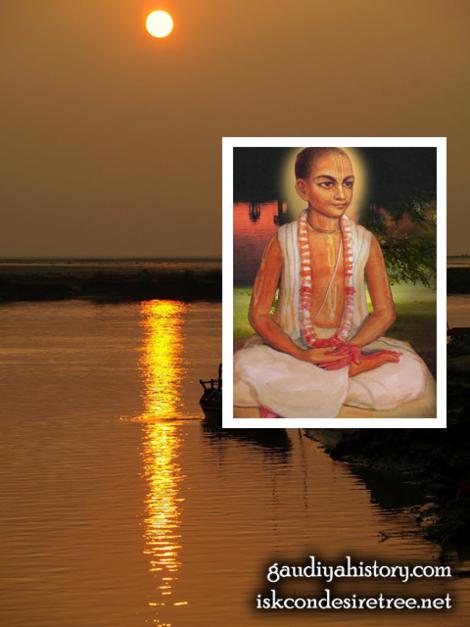On the banks of the Padmavati river, in the town of Gopalpura lived King Krishnanada Datta. His older brother was Purushottama Datta. The wealth and fame of these two brothers was beyond compare. King Krishnananda’s son was Shri Santosha Datta & Raja Krishnananda's son was Shri Narottama Dasa Thakura.
Santosha Datta took initiation from Narottama Thakura.
It appears that prior to Narottama Thakura's return from Vrindavana, his father Krishnananda and Uncle Purushottama passed away.
Krishnananda Datta appointed Santosha to the royal seat (Narottamavilasa 2). After the passing of King Krishnananda and Purushottama, he was shown much wealth and material enjoyment. From that point Santosha is referred to with the title "Raja."
Santosh was the foremost of saintly persons in the village. He was an erudite scholar as well as expert in the royal administration.

On the banks of the Padmavati river, in the town of Gopalpura lived King Krishnanada Datta. His older brother was Purushottama Datta. The wealth and fame of these two brothers was beyond compare. King Krishnananda’s son was Shri Santosha Datta & Raja Krishnananda's son was Shri Narottama Dasa Thakura. Santosha Datta took initiation from Narottama Thakura. (In the wallpaper: Shrila Narottam Das Thakur, Padma river).
When he heard that Narottama Thakura was about to bless that town with his holy footsteps after such a long time, in order to be the first one to greet Narottama, he rushed out with the rest of the Devotees to wait for him on the road outside Kheturi Gram.
After some time, Narottama could be seen in the distance. Upon seeing him, Santosh, after bowing prostrate with full obeisances, went forward with tears of ecstasy in his eyes, falling on the ground again and again to take the dust of Narottama’s lotus feet. At this, Narottama affectioantely embraced Santosh and asked how he had been faring all the time, asking him many questions about his health, happiness and well-being.
A few days later, Narottama Thakur initiated Santosh with the Radha-Kirshna mantra.
Raja Santosh Datta had previously wanted that a Temple to be built and a Deity installed. Now he begged at Narottama Thakura’s lotus feet for his permission. Narottama gladly gave his approval. Within a few months, Raja Santosh Datta had seen to it that a large Temple was built. The Temple compound included a big storehouse for food, a kirtan hall, a residence hall and ashram for Devotees, a bathing and, a beautiful flower garden, and a guest house. On the full moon day of Phalguna on the festival day of Mahaprabhu’s appearance the Temple was dedicated and the Deities were installed and a great festival, which can only be compared to the Rajasuya-yajna of Yudhishthira Maharaja in its vast expasivness began and was celebrated for miles around. Messengers were sent out for miles around Kheturi Gram, to near and distant lands, to invite kings, landowners, poets, pandits, Vaishnavas, authors, as well as many other illustrious guests. Some were sent far and wide to invite the topmost singers and orators. Preparations were made to install six Deities at one time.
When Santosha received word from Shrinivasa Acharya that the lost books of the Goswamis had been recovered, Santosha celebrated the event in his kingdom (BRK. 7.269)
Santosha bore the entire cost incurred on the occasion of the installation of Deities by Narottama. Some believe that Basanta Datta was another name of Santosha Datta. When Shyamananda prabhu arrived at Kheturi, King Santosha Datta warmly welcomed him (BRK. 7.308)
The drama Sangitamadhava was written with the consent of Santosha Datta (BRK 1.461-462).